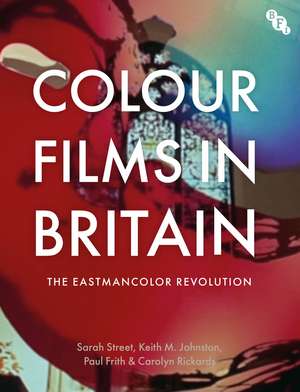Colour Films in Britain: The Eastmancolor Revolution
Autor Sarah Street, Keith M. Johnston, Paul Frith, Carolyn Rickardsen Limba Engleză Paperback – 15 dec 2021
| Toate formatele și edițiile | Preț | Express |
|---|---|---|
| Paperback (1) | 186.06 lei 3-5 săpt. | +54.22 lei 7-11 zile |
| Bloomsbury Publishing – 15 dec 2021 | 186.06 lei 3-5 săpt. | +54.22 lei 7-11 zile |
| Hardback (1) | 511.20 lei 3-5 săpt. | |
| Bloomsbury Publishing – 15 dec 2021 | 511.20 lei 3-5 săpt. |
Preț: 186.06 lei
Nou
Puncte Express: 279
Preț estimativ în valută:
35.61€ • 36.46$ • 29.62£
35.61€ • 36.46$ • 29.62£
Carte disponibilă
Livrare economică 25 februarie-11 martie
Livrare express 11-15 februarie pentru 64.21 lei
Preluare comenzi: 021 569.72.76
Specificații
ISBN-13: 9781911239574
ISBN-10: 1911239570
Pagini: 384
Ilustrații: 153 colour illus
Dimensiuni: 189 x 246 x 21 mm
Greutate: 1.04 kg
Editura: Bloomsbury Publishing
Colecția British Film Institute
Locul publicării:London, United Kingdom
ISBN-10: 1911239570
Pagini: 384
Ilustrații: 153 colour illus
Dimensiuni: 189 x 246 x 21 mm
Greutate: 1.04 kg
Editura: Bloomsbury Publishing
Colecția British Film Institute
Locul publicării:London, United Kingdom
Caracteristici
A sequel to Sarah Street's Colour Films in Britain, which provided a history of how colour film changed British film-making from 1900 to 1955, which won the BAFTSS prize for best single-authored book in 2014
Notă biografică
Sarah Street is Professor of Film at the University of Bristol, UK. Her publications on colour film include Colour Films in Britain: The Negotiation of Innovation, 1900-55 (2012), three co-edited collections: Color and the Moving Image: History, Theory, Aesthetics, Archive (2012) and British Colour Cinema: Practices and Theories (2013) (both with Simon Brown and Liz Watkins), and The Colour Fantastic: Chromatic Worlds of Silent Cinema (with Giovanna Fossati, Victoria Jackson, Bregt Lameris, Elif Rongen-Kaynakci and Joshua Yumibe). Keith M. Johnston is Reader in Film & Television Studies at the University of East Anglia, UK. He is also the author of Coming Soon: Film Trailers and the Selling of Hollywood Technology (McFarland & Co, 2009), Science Fiction Film: A Critical Introduction (Bloomsbury, 2011), and co-editor of Ealing Revisited (BFI 2012).Paul Frith is a Research Associate at the University of East Anglia, UK. He has published articles in The Journal of British Cinema and Television and Horror Studies. Carolyn Rickards is a Research Associate at the University of Bristol, UK. She has published articles in the Journal of British Cinema and Television and a chapter in Fantasy / Animation: Connections Between Media, Mediums and Genres (2018).
Cuprins
IntroductionSection 1: What is Eastmancolor?1. Branding and Marketing the Eastmancolor Revolution2. Eastmancolor, the British Film Industry, and InstitutionsSection 2: Eastmancolor and British Genre Films3. Comedy and Satire4. Social realism / contemporary drama5. The Colour of Crime6. Fantasy, Horror and Science Fiction7. Historical and costume films8. Musicals, pop films, and the concert filmSection 3: Eastmancolor Outside the Mainstream9. Key colourists, 1955-8510. Art, experimental, and avant-garde practices11. Eastmancolor and the Amateur Film12. Short and Documentary Films13. The Colour of Sex? Eastmancolor and the Sex FilmSection 4: Preservation and Restoration14. Cultures and Practices of Preservation and RestorationConclusionFirst Appendix: Eastmancolor Film List, 1954-85Second Appendix: Technical Appendix
Recenzii
Rooted in detailed primary research into aesthetics, production practices, technologies and institutions, Colour Films in Britain, provides a comprehensive and illuminating consideration of the adoption, diffusion and popularization of colour in British cinema from the mid-1950s.
Colour Films in Britain is a landmark study of the transition to colour that occurred in the 1960s and 1970s. No other book has yet tackled this transition with such depth, breadth and precision. The collaborative efforts of Sarah Street, Keith M. Johnston, Paul Frith and Carolyn Rickards are a model for research that I hope will soon be taken up in other national and transnational contexts.
Colour Films in Britain is a landmark study of the transition to colour that occurred in the 1960s and 1970s. No other book has yet tackled this transition with such depth, breadth and precision. The collaborative efforts of Sarah Street, Keith M. Johnston, Paul Frith and Carolyn Rickards are a model for research that I hope will soon be taken up in other national and transnational contexts.
